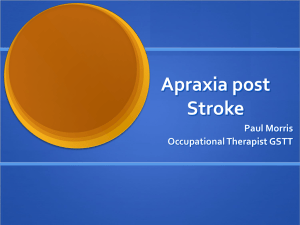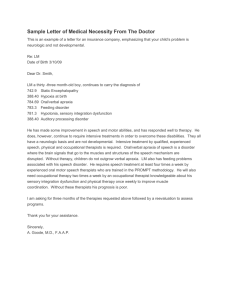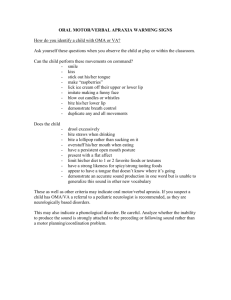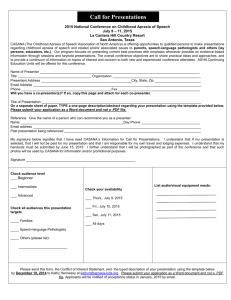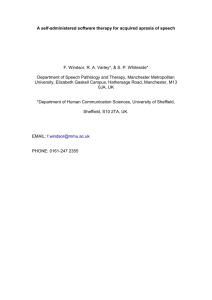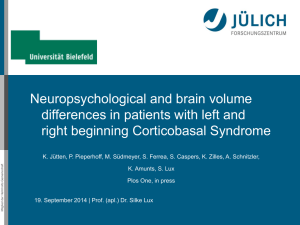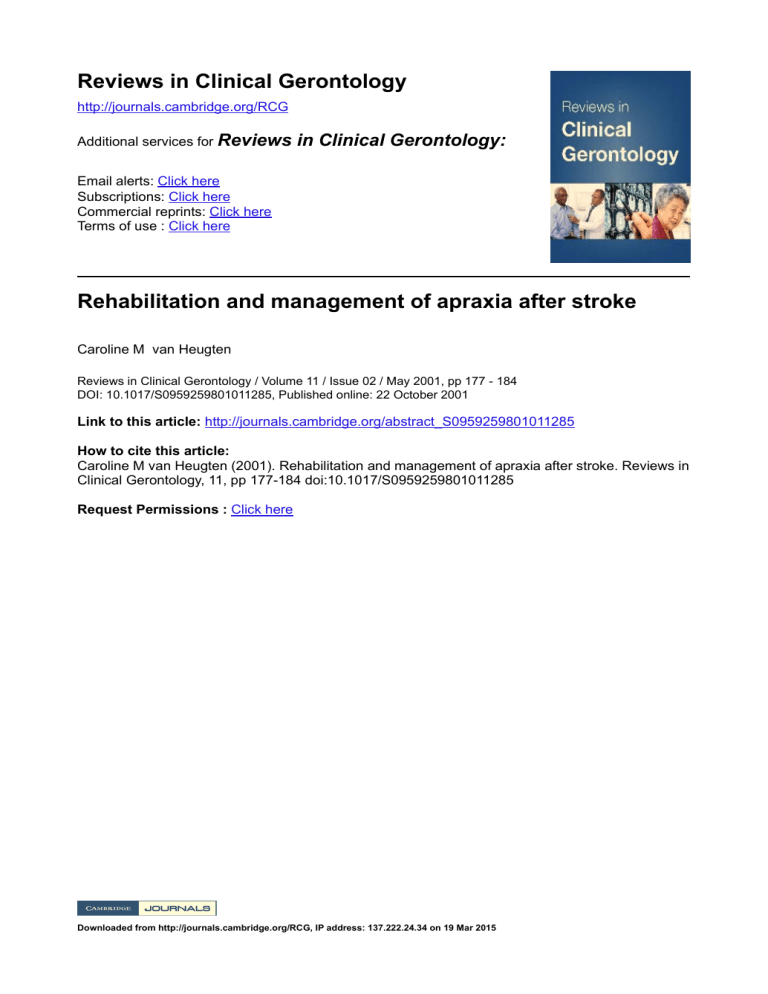
Reviews in Clinical Gerontology http://journals.cambridge.org/RCG Additional services for Reviews in Clinical Gerontology: Email alerts: Click here Subscriptions: Click here Commercial reprints: Click here Terms of use : Click here Rehabilitation and management of apraxia after stroke Caroline M van Heugten Reviews in Clinical Gerontology / Volume 11 / Issue 02 / May 2001, pp 177 - 184 DOI: 10.1017/S0959259801011285, Published online: 22 October 2001 Link to this article: http://journals.cambridge.org/abstract_S0959259801011285 How to cite this article: Caroline M van Heugten (2001). Rehabilitation and management of apraxia after stroke. Reviews in Clinical Gerontology, 11, pp 177-184 doi:10.1017/S0959259801011285 Request Permissions : Click here Downloaded from http://journals.cambridge.org/RCG, IP address: 137.222.24.34 on 19 Mar 2015 Reviews in Clinical Gerontology 2001 11; 177–184 Rehabilitation and management of apraxia after stroke Caroline M van Heugten Institute for Rehabilitation Research and Rehabilitation Centre, Hoensbroek, The Netherlands Introduction A stroke patient puts on his shoes and then tries to put on his socks over his shoes. Entering the kitchen, this patient puts milk in the teapot, places the sugar bowl in the oven, and tries to drink from the milk jug. This patient is most probably apractic. Apraxia is one of the four classical neuropsychological deficits – such as agnosia, amnesia and aphasia – causing restrictions in the ability to carry out purposeful and learned activities. One of the first definitions of apraxia was given by Geschwind1: ‘Disorders of the execution of learned movements which cannot be accounted for by either weakness, inco-ordination, or sensory loss, nor by incomprehension of, or inattention to commands.’ Although much has been written since Steinthal2 first used the term apraxia, it remains a difficult concept for both clinicians and researchers. Tate and McDonald3 refer to apraxia as ‘the clinician’s dilemma’ and, for assessment of apraxia, this is still true to a large extent, since clinical batteries need improvement and reliable diagnostic criteria are needed. Recent intervention studies have shed some light on the issue of management and treatment of apraxia: positive treatment effects have been found reducing the disrupting influence of apraxia on everyday life.4,5,6 The latest attempts of intervention were directed to functional and pragmatic treatment approaches in natural environments, which was already suggested by Maher and Ochipa.7 Unfortunately, there are still researchers and clinicians neglecting apraxia and the need to treat these patients seriously. In a recent systematic review on evidence-based cognitive rehabilitation leading to recommendations for clinical practice,8 apraxia was not even entered into the search as a key Address for correspondence: CM van Heugten, Institute for Rehabilitation Research, P.O. Box 192, 6430 AD Hoensbroek, The Netherlands. word. The practical significance and ecological impact of apraxia should however convince the clinician to incorporate the treatment of apraxia into the overall rehabilitation programme. In this paper, the rehabilitation and management of apraxia after stroke is discussed on the basis of a review of studies on the treatment and effectiveness of treatment of apraxia. By means of introduction, some issues concerning apraxia in general and assessment of apraxia in particular are presented. Apraxia: the clinical picture Apraxia is usually found in stroke patients with a left-hemispheric lesion. The exact prevalence of apraxia is not known, but different studies conclude that approximately one-third of the leftbrain damaged patients are found to be apractic.9,10 Apraxia and aphasia frequently coexist and the association between the two deficits is likely due to the involvement of contiguous structures.3,9 Many different forms and classifications of apraxia are described in the literature, but there is not one accepted taxonomy. Ideational and ideomotor apraxia have been the object of most studies in recent years and are sometimes labelled as the two classic forms of apraxia.3 A patient with ideational apraxia does not know what to do because the idea or concept of the motor act is lacking, while a patient with ideomotor apraxia does know what to do, but not how to do it.9 The types of error one can observe in ideational apraxia are omissions, mislocation or misuse of objects and sequence errors.11 The most frequent errors in ideomotor apraxia are the use of body-parts as objects, spatial orientation problems, inappropriate hand postures, perseverations and content errors.12-14 Patients with ideomotor apraxia may not be able to perform on command, while exactly the same activity may be executed perfectly in a natural setting.15 178 CM van Heugten Assessment Tate and McDonald reviewed the literature on apraxia from three perspectives: definitions, taxonomies and examination procedures.3 On the basis of their review, the authors refer to apraxia as ‘the clinician’s dilemma’: clinicians are faced with inconsistencies and contradictions in terminology, poorly defined concepts, and the lack of integration between empirical results and clinical practice. They present an overview of testing procedures using many different task demands and quantitative and qualitative scoring methods. Error analyses are in general less reliable than quantitative methods, but these methods have provided some insight into praxis performance. The reader interested in this description should consult their paper, as well as some other reviews.3,16,17 In short, all authors conclude that no standardized methods of praxis assessment seem to be available. Methods which are used in empirical studies are not easily applied in clinical practice and many clinicians rely on clinical reasoning and personal experience.18 The clinician can, however, be supported by the notions of two recent studies on the assessment and treatment of apraxia4,5 in which the researchers used a diagnostic procedure consisting of two complementary levels. First, a clinical assessment of apraxia was used, based on a neuropsychological test in a standardized context, including imitation of gestures, pantomime and the use of objects. This part can be used to differentiate between patients with and without apraxia. Second, standardized activities of daily living (ADL) tests are needed in order to examine to what degree the impairments in praxis function lead to problems in everyday functioning. Several standardized observational methods can be applied to assess the problems in performance and derive plans for treatment.19–22 This interplay of standardized tests and observation techniques is important in clinical practice. The underlying deficits can be made explicit to a certain degree, but the subjective elements in behaviour are also taken into account. In performing daily activities, it is important to consider the subject’s background and family and cultural influences. In certain religious cultures, for instance, the use of a kitchen knife is restricted to the adult men in the family. A woman handling a kitchen knife in a strange way is therefore not necessarily a case of apractic behaviour. Performance is not by definition inadequate if it is not within the range of possibilities of the clinician. Landry and Spaulding23 also recommend observation of the client engaged in his or her occupation. Structured testing in isolation may not correlate strongly with occupational performance, while analyses of performance errors, in addition to formal test results, will provide the therapist with meaningful information to plan interventions. Self-report devices and interviews with patients and their families should be equally appreciated in diagnostic settings. Combining the diagnostic findings of the psychologist with those of the occupational, speech and physical therapists, nurses and social workers, is advisable in the light of these issues. Recovery of apraxia The natural recovery course of apraxia has not been the focus of many studies. Basso and colleagues24 conducted one of the few studies on the recovery from ideomotor apraxia in acute stroke patients. They investigated variables which could predict the evolution of this form of apraxia. Improvement was found to take a long time and was only related to the site of the lesion: anterior lesions have a better chance of recovery than posterior lesions. Age, gender, type of aphasia, level of education, initial severity of apraxia, the presence of a second lesion in the right hemisphere and the size of the lesion had no influence. It appeared that five months after the first examination, 13 of the initial 26 patients still showed apraxia. In another study,25 the pattern of recovery of limb apraxia was investigated over a period of six months. The patterns of recovery appeared to differ between gestures. The natural course of apraxia seemed to be related to gestures which were meaningful and recognizable. A final study reported findings on the recovery of constructional apraxia five months poststroke.26 The group of left-hemispheric patients showed more improvement than the right-hemispheric group. Despite the lack of sufficient empirical evidence, many clinicians tend to think that in most patients, apraxia recovers spontaneously within the first few weeks after the lesion.7 If, however, the apraxia is still apparent after a period of spontaneous recovery, this is most probably a lasting and irreversible deficit for which rehabilitation Rehabilitation and management of apraxia after stroke should be considered. Persistent apraxia can result in considerable handicap. Influence of apraxia on daily life For a long time researchers believed that apraxia only occurred when performance was requested in testing conditions, and that patients would act correctly when performing spontaneously in a natural context.18,27,28 This would suggest that there is no negative influence on daily life and that therapy for apraxia is not necessary. In recent years, this claim has been challenged by many studies. Bjorneby and Reinvang29 found that apraxia variables were significant predictors of subsequent dependency. Sundet and colleagues30 reported similar results: apraxia variables at the start of the rehabilitation correlated significantly with the level of dependency after discharge. However, other studies4,31 have showed that apraxia has an adverse impact on ADL and the ability to return to work.32 All of these studies suggest that the treatment of apraxia should be part of a rehabilitation plan. The fact that most apractic patients seem to perform better when old routines and habits can be reinforced suggests that rehabilitation in the patient’s own environment may be the most effective treatment model. Treatment models In the area of cognitive rehabilitation, psychologists and therapists can apply many different approaches in order to promote the recovery of cognitive functions and reduce cognitive disabilities. Cognitive retraining, for instance, is aimed at recovery of the distorted function by repeated practice (‘mental body building’).33 Methods of activation and stimulation are based on the concept of plasticity within the neural substrate. However, sufficient plasticity to restore higher cognitive functions completely may not always exist.34,35 Improving cognitive functions may also be limited by a lack of generalization to everyday situations. Recovery from apraxia is not a realistic goal for therapy. Instead, the aim of rehabilitation should be to help the patient develop new patterns of cognitive activity through internal or external compensatory mechanisms, or through adaptation of the tasks or environment. The research on the rehabilitation of apraxia is sparse, but the intervention studies that have been conducted suggest 179 that compensatory strategies may be the most effective method. The recommendations from a recent review are that cognitive rehabilitation should always be directed toward improving everyday functioning by applying compensatory strategies to functional contexts.8 Occupational therapy guidelines for intervention In occupational therapy journals it is not uncommon to formulate practical guidelines based on literature reviews in combination with clinical experience. Two recent papers have addressed current occupational therapy treatments for apraxia or dyspraxia.23,36 Both papers suggest that interventions should focus on teaching new strategies. Some practical guidelines are offered as well. Instructions should be clear and concise and include feedback; physical guidance, visualization, modelling, and step-by-step verbal instructions are also found to be successful; during therapy, the training of functional activities is preferred within the usual context of the patient; and combining different modalities can assist performance in apractic patients.23 Jackson36 applies some general treatment principles to the rehabilitation of apraxia: treatment should be functional, goaloriented, structured and involve errorless learning and compensatory techniques. These guidelines are useful in clinical practice, but are not all evidence-based. Intervention studies In order to establish evidence-based recommendations on the rehabilitation of apraxia, it is essential to review the scientific literature on the effectiveness of apraxia treatment. Intervention studies on apraxia can be divided into three categories which are reviewed below. Single case studies A few single case studies on the rehabilitation of a patient with apraxia are reported. Wilson37 described a case of remediation of apraxia following an anaesthetic accident. In the treatment programme, the activities were broken down into small steps which were practised a few times together with the patient, supported by the overt verbalization of an occupational therapist. Selfhelp skills improved as a result of this approach. 180 CM van Heugten Maher and colleagues38 studied the effects of treatment on a 55-year-old man with ideomotor apraxia and preserved gesture recognition. Daily one-hour therapy sessions were given during a two-week period. During therapy sessions, many cues were offered which were withdrawn systematically while feedback and correction of errors were given as well. The production of gestures improved qualitatively. Ochipa and colleagues39 subsequently developed a treatment programme aimed at specific error types. Praxis performance was studied in two stroke patients. It appeared that both patients achieved considerable improvements in performance, but the observed effects were treatment-specific: treatment of a specific error type did not improve across untreated gestures. Jantra and colleagues40 studied a 61year-old man with a right-sided stroke followed by apractic gait. After three weeks of gait training supplemented with visual cues, the patient became independent with safe ambulation. Pilgrim and Humphreys41 described the use of an educational approach for the rehabilitation of brain-damaged children and adults, aimed at functional motor goals42 in a left-handed head-injured patient with ideomotor apraxia of the left upper limb. The principle of this treatment was to restore performance through a restructuring of the functional system by involving the role of speech in motor actions. The use of objects improved, but only for those objects that were trained. Bergego and others43 report the successful use of re-education treatment of the use of objects in an apractic patient. Butler44 conducted a case-study exploring the effectiveness of tactile and kinesthetic stimulation as an intervention strategy, in addition to verbal and visual mediation input, in the rehabilitation of a man with ideomotor and ideational apraxia following a head injury. In this training, the patient is cued to look at what he is doing and where he is going, and demonstrating activities and movements, thereby giving a visual model. In addition, the patient is encouraged to verbalize performance and its results. Evaluation of the motor performance in an ABA design showed mixed results related to an intervention effect. The hypothesis that additional sensory stimulation could increase motor performance was supported partially. The study however had some limitations because the results could in part be explained by motor recovery and some ceiling effects were present. In all of these single-case studies, some form of strategy-training was applied, in which the impaired function was compensated for by cueing and feedback techniques addressing additional systems, such as speech, vision, and touch. Quasi- and pre-experimental effect studies In 1998, Goldenberg and Hagman published a study in which a therapy of activities of daily living was evaluated in fifteen apractic patients who made errors in performance.4 The researchers distinguish fatal errors, which prevented successful completion of the activity, and reparable errors. It appeared that the number of errors correlated with clinical measures of apraxia (such as imitation, pantomime and object use). The aim of therapy was restoration of independence in ADL through ADL training by an occupational therapist occurring five times a week. Patients who made fatal errors in at least two out of three activities were admitted to the therapy study. Each week one of the three activities was trained, while the other two activities were given maximum support during daily routines. Every week another activity was trained, and each week ADL tests were administered. After therapy, which had a mean duration of about four weeks, 10 patients could perform all three activities without fatal errors, and three patients made only one fatal error. Elimination of fatal errors was restricted to the week the activity was trained; in other words, no generalization of training effects from trained to non-trained activities was shown. It appeared that there was no spontaneous recovery of ADL capacities, but specific training could restore ADL independence for trained activities. The training effect was preserved after six months only in those patients who kept practising in their home situation. Van Heugten and colleagues5 conducted a noncontrolled intervention study to evaluate a therapy programme for stroke patients based on teaching patients strategies to compensate for the presence of apraxia. Changes were expected in ADL performance after treatment. More specifically, improvements in ADL were expected, though little change was predicted in the severity of apraxia. Thirty-three stroke patients were treated at occupational therapy departments for a period of 12 weeks. The number of treatments per week was determined by the therapist. During the treatment Rehabilitation and management of apraxia after stroke period, activities were trained that were relevant for the patients to learn. The focus of the programme was on disabilities resulting from apraxia that impaired ADL. Every two weeks an activity was chosen. The specific interventions administered during treatment corresponded with the specific problems that were assessed during standardized ADL observations. ADL were conceptualized as being composed of three successive events: the proper plan of action as well as the correct objects have to be selected (initiation), followed by adequate performance of the plan (execution), which has to be evaluated in terms of the result (controlling and if necessary correcting the activity). The specific interventions in the form of instructions, assistance and feedback were presented to the OTs in a protocol. The following measurements were conducted: an apraxia test, a test of motor functioning, standardized observation of four activities of daily living, the Barthel index and an ADL questionnaire for the patients and the therapists. The neuropsychological apraxia test consisted of two subsets: demonstrating the use of objects and imitating gestures. The standardized ADL observations consisted of four activities being scored on four aspects: independence, initiation, execution and control. Subsequently, the four measures were added to arrive at a total ADL score. The results showed large improvements in ADL functioning on all measures and small improvements on the apraxia test and motor functioning test. The effect sizes for the disabilities, ranging from 0.92 to 1.06, were large, compared to the effect sizes for the apraxia test (0.34) and motor functioning (0.19). The significant effect of treatment was also seen when individual improvement and subjective improvement was considered. These results suggest that the therapy programme seems to be successful in teaching patients compensatory strategies that enable them to function more independently, despite the lasting presence of apraxia. Experimental effect studies Poole45 published a study in which the ability of participants with left-hemisphere stroke to learn one-handed shoe-tying was examined. Participants were five stroke patients with, and five without apraxia, and five control patients. Retention was assessed after a five-minute interval during which participants performed other tasks. 181 All groups differed significantly with regard to the number of trials needed to learn the task of shoe-tying with one hand. However, on the retention task, the stroke patients with apraxia required significantly more trials than the other two groups. All groups required fewer tasks on the retention tasks than the learning task. Poole concluded that stroke patients with apraxia have difficulty learning and retaining a functional sequencing task. These findings confirm clinical observations showing that apractic patients have difficulties learning new ADL techniques. Two randomized controlled trials on the rehabilitation of apraxia have been recently reported.6,46 One study on limb apraxia46 was conducted in thirteen patients with acquired brain injury in the left hemisphere and limb apraxia lasting more than two months. Patients were randomly assigned to a study group receiving experimental training for limb apraxia or a control group receiving conventional treatment for aphasia. The experimental training involved a behavioural training with gesture-production exercises. Thirty-five sessions of fifty minutes each were given. The patients receiving the experimental training showed a significant improvement of performance on ideational and ideomotor apraxia tests. On both tests they also showed a reduction of errors. Control patients did not show any significant change in performance. The authors conclude that their specific training program is possibly effective for the treatment of limb apraxia. In addition, the improvement was not restricted to trained items, but extended to gestures requested during assessment. This study, however, also leaves at least one important question to be answered: is this specific rehabilitation programme also useful in improving gestural performance under daily-life conditions? The goal of the study by Donkervoort and others6 was to determine the efficacy of strategy training in left-hemisphere stroke patients with apraxia. The main expectations to be tested were: (1) that strategy training incorporated into the usual treatment by occupational therapists will lead to more independence than the usual treatment alone; (2) while there will be no differential effect with regard to the apractic impairment itself; and (3) it is expected than the usual treatment by occupational therapists will lead to more improvement in motor functioning as a result of more time being available for training 182 CM van Heugten motor functions. The group of patients receiving strategy training were given the same training as in the study by van Heugten et al.5 The main focus of the therapy for the control group of patients was on sensorimotor impairments and disabilities. This treatment was mainly based on trial and error and the experience of the therapist. Patients were assessed at baseline, post-treatment (eight weeks) and follow-up (20 weeks). During the study, 315 patients with apraxia were referred for OT treatment; 113 patients were eligible for the study, of which 56 were allocated to strategytraining and 57 to the usual treatment. The amount of therapy did not differ significantly between the treatment groups; the content of treatment, in terms of training for motor impairments, cognitive training, advice, splinting, aids and housing adjustments, did not differ either. The use of other therapies was equally divided between both groups, but the strategy training group received more ADL training, which was to be expected. Patients in the strategy-training group improved more on the primary outcome measure (p=0.03). The matching effect size (0.37) indicates that strategy training is associated with a small to medium effect on ADL functioning. The Barthel index showed a significant medium effect (0.48) in favour of strategy-training. However, at follow-up, no significant differences between the two groups were found. Indications for treatment The identification of patients who will benefit most from a specific treatment is important for caregivers in order to set realistic treatment goals and allocate health care services efficiently. Perhaps even more importantly, the patient and the family should be informed adequately about the expected outcome. As noted earlier, a few studies confirmed the negative impact of apraxia on everyday functioning and the increased dependency seen in patients in whom apraxia was present at the start of rehabilitation. The only factor found to be related to recovery was the site of the lesion, which cannot be influenced by therapy. In the two studies on the efficacy of strategy-training for patients with apraxia,5,6 correlational and subgroup analyses were conducted with respect to the primary outcome measures to determine specific treatment effects. The results of both studies suggested that strategy-training was more beneficial in patients with more severe forms of apraxia. The expectation that most apractic patients have additional other impairments was confirmed, but these negative influences on daily functioning did not disturb the outcome of treatment. The study by van Heugten5 suggests that neither the presence of additional cognitive or motor problems nor age should be an indication for refraining from treating apraxia. Conclusions In recent years, the management and treatment of apraxia has received more research interest and clinical attention. Several studies have demonstrated the negative impact apraxia can have on everyday life, which should serve as a strong motivation for clinicians to address apraxia during rehabilitation. Studies on the effectiveness of apraxia treatment have shown that compensatory strategies may be the most effective approach. Treatment should focus on functional activities which are structured and practised using errorless learning approaches. Recovery from apraxia should not be the goal of rehabilitation. Further studies of treatment interventions are needed which also address how generalizable treatment effects are to non-trained activities and situations. References 1 Geschwind N. The apraxias: neural mechanisms of disorders of learned movements. Am Scientist 1975; 63: 188–95. 2 Steinthal P. Abris der Sprachwissenschaft. Berlin: Krager, 1871. 3 Tate RL, McDonald S. What is apraxia? The clinician’s dilemma. Neuropsychol Rehab 1995; 5: 273–97. 4 Goldenberg G, Hagman S. Therapy of activities of daily living in patients with apraxia. Neuropsychol Rehab 1998; 8: 123–41. 5 Heugten CM van, Dekker J, Deelman BG, Dijk AJ van, Stehmann-Saris JC, Kinebanian A. Outcome of strategy training in stroke patients with apraxia: a Phase II study. Clin Rehab 1998; 12: 294–303. 6 Donkervoort M, Dekker J, Stehmann-Saris JC, Deelman BG. Efficacy of strategy training in left hemisphere stroke patients with apraxia: a randomized clinical trial. Neuropsychol Rehab (in press). 7 Maher LM , Ochipa C. Management and treatment of limb apraxia. In: Rothi LJG, Rehabilitation and management of apraxia after stroke 8 9 10 11 12 13 14 15 16 17 18 19 20 21 22 Heilman KM eds. Apraxia: the neuropsychology of action. Hove: Psychology Press, 1997. Cicerone KD, Dahlber C, Kalmar K et al. Evidence-based cognitive rehabilitation: recommendations for clinical practice. Arch Phys Med Rehab 2000; 81: 1596–615. De Renzi E. Apraxia. In: Boller F, Grafman J eds. Handbook of Neuropsychology, Volume 2. Amsterdam: Elseviers Science Publishers, 1989. Donkervoort M, Dekker J, van den Ende E, Stehmann-Saris JC, Deelman BG. Prevalence of apraxia among patients with a first lefthemisphere stroke in rehabilitation centers and nursing homes. Clin Rehab 2000; 14: 130–36. De Renzi E, Lucchelli F. Ideational apraxia. Brain 1988; 111: 1173–85. Heilman KM, Gonzalez-Rothi LJ. Apraxia. In: Heilman KM, Valenstein E eds. Clinical Neuropsychology, second edition. Oxford: Oxford University Press, 1985. Miller N. Dyspraxia and its management. London: Croom Helm, 1986. Shelton PA, Knopman DS. Ideomotor apraxia in Huntington’s disease. Arch Neurol 1991; 48: 35–41. De Renzi E, Motti F, Nichelli P. Imitating gestures: a quantitative approach to ideomotor apraxia. Arch Neurol 1980; 37: 6–18. Rothi LJG, Heilman KM. Apraxia: the neuropsychology of action. Psychology Press, Hove, 1997. De Renzi E. Models of limb apraxia examination and their bearing on the interpretation of the disorder. In: Roy EA ed. Neuropsychological studies and related disorders. Amsterdam: Elseviers Science, 1985. Poeck K. Cues to the nature of disruptions in limb apraxia. In: Roy EA ed. Neuropsychological studies of apraxia and related disorders. New York: North Holland, 1985. Heugten CM van, Dekker J, Deelman BG, Stehmann-Saris, JC, Kinebanian A. Assessment of disabilities of stroke patients with apraxia: internal consistency and inter-observer reliability. Occup Ther J Res 1999; 19: 55–74. Heugten CM van, Dekker J, Deelman BG, Dijk van AJ, Stehmann-Saris JC, Kinebanian A. Measuring disabilities in stroke patients with apraxia: a validation study of an observational method. Neuropsychol Rehab 2000; 10: 401–14. Arnadottir G. The brain and behaviour. St. Louis: Mosby Company, 1990. Fisher AG. The assessment of motor and process skills. Manual 1996. Department of Occupational Therapy, Colorado State University:Three Star Press. 183 23 Landry JE,Spaulding SJ. Assessment and intervention with clients with apraxia: contributions from the literature. Can J Occup Ther 1998; 66: 52–61. 24 Basso A, Capitani E, Della Sala S, Laiacona M, Spinnler H. Recovery from ideomotor apraxia: a study on acute stroke patients. Brain 1987; 110: 747–60. 25 Maher LM, Rayner AM, Foundas A, Rothi LJG, Heilman KM. Patterns of recovery in ideomotor apraxia. Paper presented at the annual meeting of the International Neuropsychological Society, 1994, Cincinatti, OH. 26 Sunderland A, Tinson D & Bradley I. Differences in recovery from constructional apraxia after right and left hemisphere stroke? J Clin Exp Neuropsychol 1994; 16: 916–20. 27 De Renzi E, Motti F, Nichelli P. Imitating gestures: a quantitative approach to ideomotor apraxia. Arch Neurol 1980; 37: 6–18. 28 Geschwind N, Damasio AR. Apraxia. In: Frederiks JAM ed. Handbook of clinical neurology. New York: Elseviers Science Publishers, 1985. 29 Bjorneby ER, Reinvang IR. Acquiring and maintaining self-care skills after stroke. The predictive value of apraxia. Scand J Rehab Med 1985; 17: 75–80. 30 Sundet K, Finset A, Reinvang IR. Neuropsychological predictors in stroke rehabilitation. J Clin Exp Neuropsychol 1988; 10: 363–79. 31 Foundas AL, Macauley BC, Rayner AM, Maher LM, Heilman KM, Rothi LJG. Ecological implications of limb apraxia: evidence from mealtime behaviour. J Int Neuropsychol Soc 1995; 1: 62–66. 32 Saeki S, Ogata H, Okubo T, Takahashi K, Hoshuyama T. Factors influencing return to work after stroke in Japan. Stroke 1993; 24: 1182–25. 33 Zomeren AH, van Brouwer WH. Clinical neuropsychology of attention. Oxford: Oxford University Press, 1994. 34 Miller E. Recovery and management of neuropsychological impairments. New York: John Wiley & Sons, 1984. 35 Moffat N. Strategies of memory therapy. In: Wilson BA, N. Moffat N eds. Clinical management of memory problems. London: Croom Helm, 1984. 36 Jackson T. Dyspraxia: guidelines for intervention. Br J Occup Ther 1999; 62: 321–26. 37 Wilson BS. Remediation of apraxia following an anaesthetic accident. In: West J, Spinks P eds. Case studies in Clinical Psychology. Bristol: John Wright, 1988. 38 Maher LM, Rothi LJG, Greenwald ML. 184 39 40 41 42 CM van Heugten Treatment of gesture impairment: a single case. ASHA 1991; 33 : 195. Ochipa C, Maher LM & Rothi LJG. Treatment of ideomotor apraxia. J Int Neuropsychol Soc 1995; 2: 149. Jantra P, MongaTN, Press JM, Gervais BJ Management of apraxic gait in a stroke patient. Arch Phys Med Rehabil 1992; 73: 95–57. Pilgrim E, Humphreys GW. Rehabilitation of a case of ideomotor apraxia. In : Riddoch MJ, Humphreys GW eds. Cognitive neuropsychology and cognitive rehabilitation. Hover: Lawrence Erlbaum, 1994. Cotton E, Sutton A. Conductive Education: a system of overcoming motor disorder. Beckenham: Croom Helm, 1986. 43 Bergego C, Bradat-Diehi P, Taillefer C, Migeot H. Evaluation et reeducation de l’apraxie d’utilisation des objets. In : El Gall D, Aubin G eds. L’apraxie. Marseille: Solal, 1994. 44 Butler J. Intervention effectiveness: evidence from a case study of ideomotor and ideational apraxia. Br J Occupat Ther 1997; 60: 491–97. 45 Poole J. Effect of apraxia on the ability to learn one-handed shoe-tying. Occup Ther J Res 1998; 18: 99–104. 46 Smania N, Girardi F, Domenicali C, Lora E, Aglioti S. The rehabilitation of limb apraxia: a study in left-brain damaged patients. Arch Phys Med Rehab 2000: 81; 379–88.

